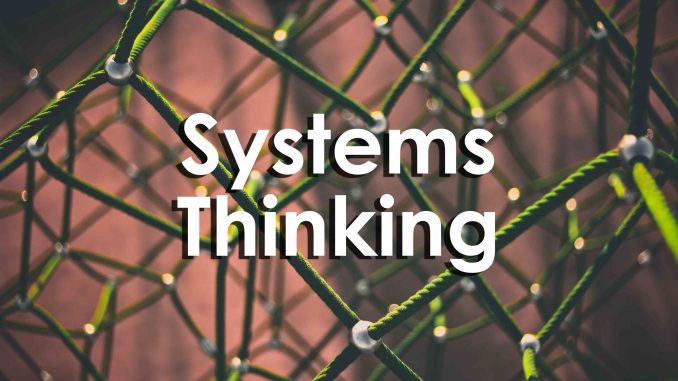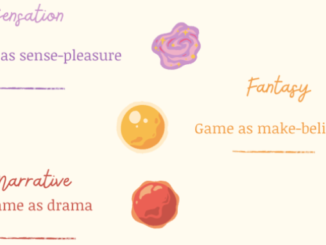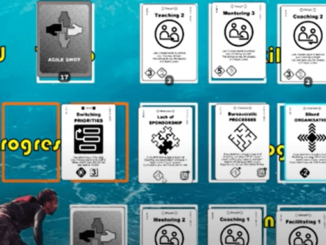
Big systems, small systems, fast systems, slow systems. Pretty much everything, everyone, and everybody that we work with is part of system: large or small. But how do those systems work and how do they affect you?
What does my work on this committee mean for the university? What does buying Marvin Gardens mean for the long game of Monopoly? Will selling off my AMEX stock really affect the London Stock Exchange?
This is SYSTEMS thinking and there are four main ways to think about them: big (macro), small (micro), simultaneously (synchronous), or linearly (asynchronous).
You got to have a system to navigate a SYSTEM, right? Keep reading to find out how.
What is Systems Thinking?
Whenever you think about a large organization like a university or a large program like orientation you are also thinking about a system. Since you’re already thinking about a system you also need to think about how it works. How do individual components (like people, places, and things) interact with each other?
Systems thinking is knowing and understanding how those different components work and relate to one another. Some of these systems are HUGE and complex like the United Nations or the ecosystem of the Pacific Ocean.
Some of these systems are really small like an individual game of Pandemic or a single flip of a coin.
All systems have at least two components: micro (small) elements and macro (big) elements. Each one requires a different understanding in order to understand the whole “system”
That understanding contributes to whether or not the system works, works well, or completely breaks down…
The Micro

Micro systems are really the “nuts and bolts” of the entire operation. In an organization these micro actions are the motions of the individual people inside of it. These can include everything as small as a mouse click and as big as a text message. These are the small components that make up the larger system.
In games, the micro play occurs during individual players’ actions. At a poker table these can be the decision to check or fold during any hand. In Scrabble it can be a decision to save that 10 point “Q” in your rack for a bigger bonus later. In a game of Hanabi it could be a decision to play a card or give a teammate a clue.
At their very basic level, micro decisions are small and personal. Sometimes people think rationally about these decisions, but for the most part we are on auto-pilot when we decide to smile at a beautiful stranger or stop at the yellow light instead of trying to make it.
The micro is about the small individual picture – it doesn’t always take into account the BIG picture – the Macro.
Macro Systems
Macro systems are the very opposite of micro systems. Macro systems are thinking about the world’s economy, our planet in the solar system, and the Pacific Ocean as a whole. Macro systems look at the forest instead of the trees. They deal with BIG changes that affect all of the little nuts and bolts in micro systems.
In games, the macro play occurs when players take their actions, opponents’ actions, and the game’s action all together. A sports commissioner looks at the records of teams playing games throughout the league. A player at the World Series of Poker sees which players are building chip stacks on a daily basis. A macro player in a game of Risk decides whether to hold a big continent like Africa for the army bonus or give it up by holding two smaller continents.
Macro play is about making LARGE sweeping decisions that affect yourself, your opponents, and the game as a whole. They take into account the decisions of many others and try to find trends in what’s happening in the big picture.
Macro play at the college level involves the creation of a new major. At the state level it involves the creation of a new campus. At the national level it involves the trend of student loan debt for college graduates.
Macro systems think big. They think HUGE! They focus on what’s come before and what’s to come next.
Synchronous

What does synchronous mean? Synchronous means that actions take place at the same time. Meetings are a great example of this: one person might be speaking but multiple people are listening (or not) and forming their own opinions. The same thing can be said about lectures, concerts, or any sort of live entertainment.
Games that have synchronous actions are Taboo with its frequent yelling, Escape: The Curse of the Hidden Temple with its crazy dice rolling, or the manic clicking of the real-time strategy game StarCraft 2.
Synchronous actions take place at the macro level like at the trading floor for the New York Stock Exchange. Millions of transactions are taking place every second to determine stock prices rising or falling.
Synchronous actions also take place on the micro level like when a running back receives the ball or when a counselor determines a follow up question based on what a patient has just said.
Synchronous actions are made in real time and are often decided based on immediately available information. But sometimes, you don’t have to think off the top of your head. Sometimes you have time to formulate a move ahead of time…
Asynchronous
Asynchronous moves are actions taken in order. In a game of Monopoly a player waits until another person’s turn is over before acting. This means that there is currently only one thing going on at a time, and it happens in a specific order. Board gamers call this “resolving” before other actions are taken.
Asynchronous actions can also take place in a large organization like a college or university. Examples of this are when a committee meets, the faculty senate holds a vote, or when students complete homework for a class the next day. In all of these situations things happen before the next person acts (i.e. committee members read an agenda, a faculty senate reviews initiatives up for vote, and students listen to a lecture in class before doing the homework).
Big asynchronous actions often take place in macro environments where large scale decisions have a big impact. You can see this whenever congress meets to vote on legislation or when the United Nations holds its general assembly. Many meetings, conversations, and other events led up to a large action now taking place.
Alternatively, asynchronous actions can also take place in micro environments like in email or chat conversations. How many times has meaning been lost in an email because the conversation spanned hours or days?
Takeaways

Things operates in systems. Colleges and universities are just as a diverse or complex as the human body or a nation. To navigate a system well you need to know how the different parts of it work together.
Some of these systems work on a really small (micro) level while others work on (macro) larger levels. Understanding both helps you understand how the entire system works. Micro actions take place in games with individual players’ actions.
On the other side Macro systems involve large organizations or groups of individuals. A single bet in a poker game is a micro action. Passing sweeping new financial regulation is a macro action.
No matter if it’s a macro or micro action they all take place either synchronously (at the same time as other actions) or asynchronously (in a specific order). Synchronous macro actions can be as big as a day’s trading on the New York Stock Exchange or as small as a game of Taboo.
Asynchronous actions take place in sequence. At a micro level they involve students doing homework before the next class or on a macro level when a governing body like the senate meets to debate previously presented legislation.
Your ability to determine 1) the micro or macro scale of an action and 2) whether or not it is synchronous or asynchronous will help you play your game and navigate your system.
Sometimes it’s beneficial to wait until you have more information before taking a turn or placing a bet.
Other times you need to act quickly to resolve an emergency like a leaking toilet or a historical financial collapse. Knowing is half the battle!
This article covered game systems in games-based learning. To learn more about how systems thinking affects gamification check out the free course on Gamification Explained.
This article was originally published by Dave in his blog What’s Your System?
If you have enjoyed this article – consider getting yourself lifetime access to his Games-Based Learning Digital Library containing all of the content from the past two Games-Based Learning Virtual Conferences; past webinars and courses he’s created; as well as his complete back catalog of articles; podcast episodes; and videos. And more content is being added all the time.
Readers of Ludogogy can get a $50 discount on this valuable resource by using this link.
- How do you Design Games for Flow State - 26th January 2024
- Accessibility in Games - 22nd November 2023
- What are Megagames? - 5th September 2023





Be the first to comment